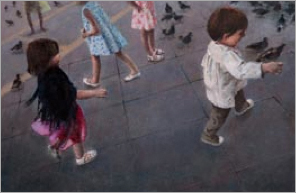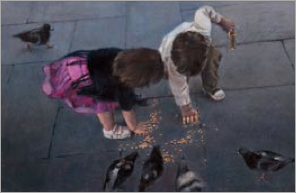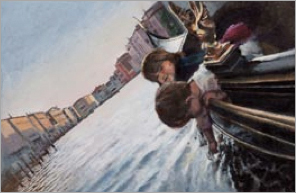Eduardo Mendoza
Introduction of Momentos exibition brochure.
MOMENTS OF SERENE BEAUTY
It is never easy to speak in general about paintings which, by definition, require to be seen and judged individually, but this is a difficulty that needs to be accepted when these paintings are presented forming a whole set and corresponding to a stage of the artistic career of the painter, in particular a recent stage. Each piece of work is valid on its own, but as a whole set they also have a meaning, a context that is fundamental for fully understanding the individual works. This difficulty, in the case of Oscar Tusquets, is aggravated because this is his first exhibition strictly speaking, in other words, the first time that Oscar Tusquets, who is well known and recognized in other fields, appears before the public as a professional painter, having painted now for several decades.
Let me clarify that Oscar has never been an amateur painter. He has not painted as a professional, but he has never painted as a simple pastime. Right from the start, he approached painting as a creative task with all it involves and he has worked this field with the capacity and technical knowledge of a professional. However, it is true that he has not done so professionally, in the sense that he has not been subjected to assessment, the public, the erratic verdict of the critics and the implacable verdict of the market. In other words, he has not earned his living by painting, nor has he had to justify his painting, nor has his painting had to justify him. The results of this lack of confrontation could be positive or negative for the artist, but the theoretical aspect of the matter is not what we are interested in looking at here. Things are what they are and we will never know what would have happened to Oscar's painting if it had been more exposed to the elements. What matters is that now a painter, in full maturity as a painter and as a person, with several decades of career behind him, during which he has reached diverse conclusions, has added and has taken away and has changed attitude with regard to painting and also with regard to reality, is now coming out into a public space.
What is now being shown is work that is apparently dispersed, but decidedly unitary in as far as it contains and expresses the world of the painter with a sincerity that the formal perfection of each piece of work cannot hide. I do not use the word hide because Oscar is shy or moderate when expressing his opinions about art, which are founded but categorical, especially about the art of representation and what is around him. This can be seen in the half a dozen books published for the edification, stimulation and, at times, exasperation of those of us who have read and enjoyed them. I would like to quote a paragraph about the artist from the first of them Más que discutible (Tusquets, 1994): "... if one blindly believes in the historical transcendence of work itself, everything that contributes to make it possible... it will be well received, while what makes it difficult —faithfulnesses, uncomfortable relationships, old commitments— will tend to be rejected. We work convinced and absorbed because we love humility so much that we are willing to sacrifice our life in an everlasting piece of work, but we do not have enough time or place to share our affection and dedication to those around us". An acid definition that is not at all applicable to its author. Oscar Tusquets is quite the opposite: loyal to his people and his beliefs; and his work is based on and is recognized in this loyalty.
The paintings of which this exhibition is made up refer to diverse components of everyday life. They are, shall we say, a chronicle of the things that capture his attention: moments of serene beauty. A well-proportioned object, the capacity of organic or inorganic matter to absorb and reflect light, the harmony of the body with regard to the moment. Oscar does not ignore the existence of what is ugly, he simply leaves it for others and stays with a pictorial world that reflects reality as it should be. In this sense, his painting is figurative but not realist. Like the great painters of the past, with whom he has always maintained a respectful, affectionate dialogue, Oscar has no hesitations about correcting defects or removing anti-aesthetic elements. This can be clearly seen in his urban landscapes. What Oscar paints really exists and the painting reproduces the reality with rigour, not forgetting elements that are fitting for the place and time: the name of the street in a square, a traffic light, a zebra crossing, a traffic sign. However what would make the image ugly is left out of the painting. There is a process of idealising which is external to the painting. The result offers scenes, people or buildings that appear independent from the world that surrounds them. They live their life in the painting. It is notable that Oscar Tusquets, who is an architect with a long, consolidated career, paints buildings as if they were people, with a treatment that would be more fitting for a portrait genre than for landscapes. Paradoxically, the contrary occurs with his portraits of people, in this case, women. Maybe it is not by chance that Oscar has only painted women and, occasionally, his self-portrait. However, I will refer to this apparently revealing feature later. For the time being, I will mention that the portraits of women do not ooze psychology but situation: a being in the world. They are all portraits, and good portraits, in as far as they are not limited to the physiognomy of the person being portrayed. They have a life of their own and each model sets up a human relationship with the viewer. The one called Villa Florita, for example, oozes spontaneity, affection, sweetness and joy; some cacti provide the contrasting note, but the spikes are not threatening: the cactus transmits the sensation of heat, a Mediterranean or tropical touch and it could be an aloe, a balsamic, curative plant. Even so, I believe that from the pictorial point of view, Oscar is more interested in the formal harmony of the female body and the quality of the skin or of the hair than the personality. On two occasions, the face of the model has been left off the canvas. This is not a shortcoming, nor is the female selection to which I referred above. What happens is that Oscar Tusquets the painter is not interested so much in reality as in the moment. He does not paint what he sees, but he paints himself seeing it. All the paintings in this exhibition and probably all the paintings that Oscar Tusquets has painted have the same subject: the perception of a moment of beauty or of harmony: women he knows and appreciates because of their beauty and their character, buildings, flowers, his dog. Perhaps in this sample, an example of what I have just said can be found in the painting called After the Party: a comfortable sofa, a bookshelf with books in the background, on the sofa some elegant woman's shoes carelessly discarded no doubt with great relief after an amusing but tiring evening, a fur stole on the back of the sofa, the light of the dawn shining in almost horizontally through the half-closed blind. A marginal moment of perfect happiness, minimal in time and forever in the memory. I would mention in passing that although his admiration and personal friendship with Dalí and with Antonio López is well known and that the influence of both of them on his conception of painting is clear, Oscar does not share the emaciated vision of Antonio López or the gruesome universe of Dalí. His world is rather the pictorial one of Morandi, with whom he has no similarity but with whom he shares the perception of shape and of light detained in time.
Banality is the threat that hovers over all works of creation, and in particular over those destined to be exhibited in public. In abstract painting, banality can go by fairly unnoticed; in conceptual art it is a positive factor in as far as it is attributed with a critical discourse. Figurative painting after avant-garde is on the edge of the abyss. Having lost its function of inspiration and of testimony, its use has been reduced to being merely decorative: painting flowers, dogs, seascapes and sunsets is playing with nitroglycerine. Oscar Tusquets knows this and faces the risk coldly. At no time does he recur to irony, parody or citation, except in his self-portrait, where he uses at least two of these resources, although the resource is justified because of the subject matter. The rest is not hidden behind any ideological presupposition nor does it appeal to any complicity. As much as he is an art theorist, when Oscar Tusquets paints he does not respond to a precept but to a conviction.
I have already said that Oscar has daring and often critical opinions about events, people, ideas and fashions. But he is not an irate or bitter man, nor does he pretend to be so. The historic, social and professional circumstances in which he has lived do not justify a resentful attitude. With regard to the adversities and personal afflictions that accompany the life of everybody and, of course, his, they have not left a dramatic reflection in his painting but they have left a slight patina of melancholia, which can be found in all his work and particularly in his recent work: the idea that beauty is inevitably accompanied by fleetingness. Oscar lives the moment with pleasure and also with gratitude. Three small paintings, like a triptych, the so-called Predella Veneziana, have his children as protagonists. Here the schemes are broken to make way for a painter who is less serene, more subjective. On this occasion, the painter's view includes the gaze of the people painted. What he shows us is not the world of the artist, but of the children. They occupy almost all the space and what is attracting their attention occupies the rest of it. Venice, with its stunning architecture, is a dim stroke in the background of the canvas for some visitors concentrated on the water and on the enjoyment of going for a boat trip. In another of the paintings, the children turn their back on the spectator, absorbed in the activity of feeding the pigeons. On the grey pavement, the grains of cereal shine like treasure.
I will finish up as I started out. Oscar Tusquets is not an amateur, but he is a new artist in this arena and this makes the balance difficult: for obvious reasons he should be judged as a painter, however, the spectator is, in some way, lacking the reference that his career would provide. I imagine that shortly a retrospective of his pictorial work will allow this gap to be filled. In any case, as I have already said and now repeat, even though he has painted in a non-professional way, he is not an amateur. The amateur senses or knows from experience the limit of his possibilities and is always on the other side. The non-amateur insists on crossing these limits and converting what started out as pleasure into an authentic torment. In Oscar’s work, we find these two factors along with a third one: satisfaction in the face of a problem solved, a fair idea, a well-finished job; something that is clear in some works of the great masters (it is the first impression that one gets in front of a Velázquez or a Vermeer) and which Oscar cannot avoid on some occasions, although modestly, as in the Ocho vasos romanos y uno mío, with its relieves, its shadows and its plays with light, not forgetting the joke of adding one of his own pieces together with the representatives of classicism. However, I insist that the exhibitionism is modest, starting with the subject matter: beautiful but humble ornamental objects.
Anyway, Oscar Tusquets’ painting aims to be something more than a set of beautiful but humble ornamental objects. Each piece of work flows in its own life space and the whole set reveals the painter's world. Nothing more and nothing less.



Predella Veneziana, 2008







